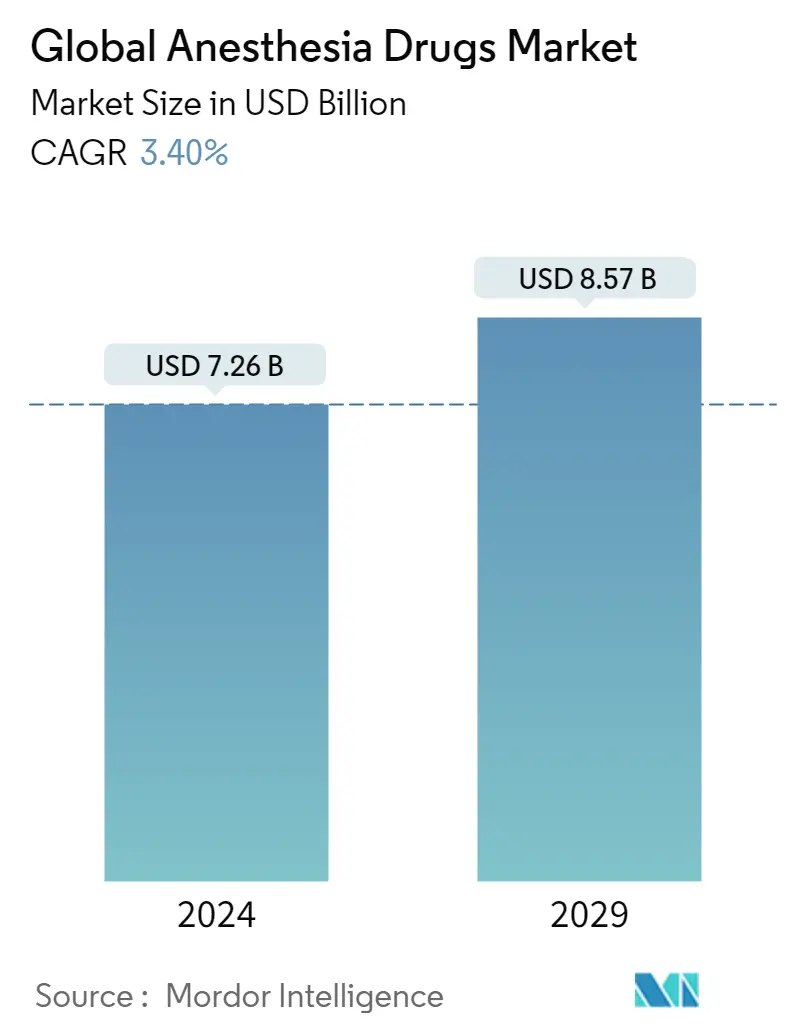Market Size of Global Anesthesia Drugs Industry

| Study Period | 2019 - 2029 |
| Market Size (2024) | USD 7.26 Billion |
| Market Size (2029) | USD 8.57 Billion |
| CAGR (2024 - 2029) | 3.40 % |
| Fastest Growing Market | Asia Pacific |
| Largest Market | North America |
Major Players
*Disclaimer: Major Players sorted in no particular order |
Anesthesia Drugs Market Analysis
The Global Anesthesia Drugs Market size is estimated at USD 7.26 billion in 2024, and is expected to reach USD 8.57 billion by 2029, growing at a CAGR of 3.40% during the forecast period (2024-2029).
Due to the emergence of the pandemic situation, demand for anesthesia drugs decreased slightly in 2020, resulting in surgeries being postponed or canceled. According to a study published in the British Journal of Surgery in May 2020, around 28.4 million elective surgeries worldwide were estimated to be canceled or postponed, based on 12 weeks of peak disruption to hospital services due to COVID-19. However, as activities resume, all of the elective surgeries that had been postponed are now being completed, increasing anesthesia drug consumption.
The primary factors propelling the growth of this market are the rising number of surgeries and new anesthesia drug approvals. According to the American Society of Plastic Surgeons, in 2020, 2.3 million cosmetic surgical procedures, 13.2 million cosmetic minimally invasive procedures, and 6.8 million reconstructive procedures were performed in the United States 2020, representing a 3% increase over 2019. This indicates the rising number of surgeries, which ultimately results in the rising demand for anesthesia drugs.
Moreover, according to the article 'Trauma of Major Surgery' published in the National Center for Biotechnology Information (NCBI) in July 2020, globally, a staggering 310 million major surgeries are performed each year. Similarly, according to the article titled 'Incidence and Cumulative Risk of Major Surgery in Older Persons in the United States published in July 2021, in the United States, Nearly nine major surgeries were performed annually for every 100 older persons, and more than 1 in 7 Medicare beneficiaries underwent a major surgery over five years, representing nearly 5 million unique older people.
Furthermore, the development and approvals of novel local anesthesia drugs are proving to be a new revenue-generating resource for market players. For instance, in February 2021, PainPass launched the first Cannabidiol (CBD)/lidocaine product line targeting those with chronic pain and for numbing muscles externally. In December 2021, Hikma Pharmaceuticals PLC (Hikma), has launched Bupivacaine HCl Injection, USP through its United States affiliate, Hikma Pharmaceuticals United States Inc. The company has launched 0.25%, 0.5% and 0.75% in 10mL and 30mL doses. Moreover, in June 2021, PAION AG received United Kingdom Medicines & Healthcare products Regulatory Agency (MHRA) approval for Byfavo (remimazolam besylate) in adults for procedural sedation.
Thus, all aforementioned factors, such as the increasing number of surgical procedures and product launches, boost the market over the forecast period.
Anesthesia Drugs Industry Segmentation
As per the scope of the report, anesthesia is a drug that induces a reversible loss of sensation. Anesthesia is one of the essential components of any surgical procedure. It induces temporary unconsciousness and loss of protective reflexes. General anesthesia drugs suppress the activities of the central nervous system and induce a complete lack of sensation. Local anesthetics restrict the transmission of nerve impulses from the targeted region to the spinal cord. The anesthesia drugs market is segmented by drug type (general anesthesia drugs and local anesthesia drugs), route of administration (inhalation, injection, and other routes of administration), application (general surgery, cosmetic surgery, plastic surgery, dental surgery, and other applications), and geography (North America, Europe, Asia-Pacific, Middle-East and Africa, and South America). The market report also covers the estimated market sizes and trends for 17 different countries across major regions globally. The report offers market size and forecasts in value (USD million) for the above segments.
| By Drug Type | |||||||||
| |||||||||
|
| By Route of Administration | |
| Inhalation | |
| Injection | |
| Other Routes of Administration |
| By Application | |
| General Surgery | |
| Plastic Surgery | |
| Cosmetic Surgery | |
| Dental Surgery | |
| Other Applications |
| Geography | ||||||||
| ||||||||
| ||||||||
| ||||||||
| ||||||||
|
Global Anesthesia Drugs Market Size Summary
The anesthesia drugs market is poised for steady growth over the forecast period, driven by an increasing number of surgical procedures and the introduction of new anesthesia drugs. The market experienced a temporary decline in demand due to the COVID-19 pandemic, which led to the postponement of elective surgeries. However, as healthcare activities resumed, the demand for anesthesia drugs surged to accommodate the backlog of surgeries. The market is further bolstered by the development and approval of innovative local anesthesia drugs, which present new revenue opportunities for industry players. The rising prevalence of surgeries, including cosmetic and reconstructive procedures, is a significant factor contributing to the market's expansion. Propofol, a widely used general anesthetic, continues to play a crucial role in the market due to its extensive application in various surgical procedures and critical care settings.
North America currently leads the anesthesia drugs market, with the United States being the largest regional market globally. The region's dominance is attributed to the high volume of surgical procedures, an aging population with chronic conditions, and advancements in anesthesia technologies. The market is characterized by intense competition, with major players holding substantial market shares. However, the landscape is evolving as mid-size and smaller companies introduce new products at competitive prices, expanding their market presence. The ongoing development of new anesthesia drugs and strategic partnerships, such as those seen in the United States and Europe, are expected to further drive market growth. The market's competitive nature and the continuous introduction of innovative products underscore the dynamic environment in which anesthesia drugs are marketed and distributed.
Global Anesthesia Drugs Market Size - Table of Contents
-
1. MARKET DYNAMICS
-
1.1 Market Overview
-
1.2 Market Drivers
-
1.2.1 Increasing Number of Surgeries
-
1.2.2 New Approvals of Anesthesia Drugs
-
1.2.3 Reduction in the Cost of Newly Invented Drugs
-
-
1.3 Market Restraints
-
1.3.1 Side Effects of General Anesthetics
-
1.3.2 Lack of Skilled Anesthetics
-
-
1.4 Porter's Five Forces Analysis
-
1.4.1 Threat of New Entrants
-
1.4.2 Bargaining Power of Buyers/Consumers
-
1.4.3 Bargaining Power of Suppliers
-
1.4.4 Threat of Substitute Products
-
1.4.5 Intensity of Competitive Rivalry
-
-
-
2. MARKET SEGMENTATION (Market Size by Value - USD million)
-
2.1 By Drug Type
-
2.1.1 General Anesthesia Drugs
-
2.1.1.1 Propofol
-
2.1.1.2 Sevoflurane
-
2.1.1.3 Desflurane
-
2.1.1.4 Dexmedetomidine
-
2.1.1.5 Remifentanil
-
2.1.1.6 Midazolam
-
2.1.1.7 Other General Anesthesia Drugs
-
-
2.1.2 Local Anesthesia Drugs
-
2.1.2.1 Bupivacaine
-
2.1.2.2 Ropivacaine
-
2.1.2.3 Lidocaine
-
2.1.2.4 Chloroprocaine
-
2.1.2.5 Prilocaine
-
2.1.2.6 Benzocaine
-
2.1.2.7 Other Local Anesthesia Drugs
-
-
-
2.2 By Route of Administration
-
2.2.1 Inhalation
-
2.2.2 Injection
-
2.2.3 Other Routes of Administration
-
-
2.3 By Application
-
2.3.1 General Surgery
-
2.3.2 Plastic Surgery
-
2.3.3 Cosmetic Surgery
-
2.3.4 Dental Surgery
-
2.3.5 Other Applications
-
-
2.4 Geography
-
2.4.1 North America
-
2.4.1.1 United States
-
2.4.1.2 Canada
-
2.4.1.3 Mexico
-
-
2.4.2 Europe
-
2.4.2.1 Germany
-
2.4.2.2 United Kingdom
-
2.4.2.3 France
-
2.4.2.4 Italy
-
2.4.2.5 Spain
-
2.4.2.6 Rest of Europe
-
-
2.4.3 Asia-Pacific
-
2.4.3.1 China
-
2.4.3.2 Japan
-
2.4.3.3 India
-
2.4.3.4 Australia
-
2.4.3.5 South Korea
-
2.4.3.6 Rest of Asia-Pacific
-
-
2.4.4 Middle-East and Africa
-
2.4.4.1 GCC
-
2.4.4.2 South Africa
-
2.4.4.3 Rest of Middle-East and Africa
-
-
2.4.5 South America
-
2.4.5.1 Brazil
-
2.4.5.2 Argentina
-
2.4.5.3 Rest of South America
-
-
-
Global Anesthesia Drugs Market Size FAQs
How big is the Global Anesthesia Drugs Market?
The Global Anesthesia Drugs Market size is expected to reach USD 7.26 billion in 2024 and grow at a CAGR of 3.40% to reach USD 8.57 billion by 2029.
What is the current Global Anesthesia Drugs Market size?
In 2024, the Global Anesthesia Drugs Market size is expected to reach USD 7.26 billion.

